Page 3473 of 4770
± ENGINE MECHANICAL (5S±FE)ENGINE UNIT
EM±81
1253 Author�: Date�:
38. INSTALL AIR CLEANER CAP
(a) Connect the air cleaner hose to the throttle body.
(b) Attach the air cleaner cap to the air cleaner case, and
install the 2 clamps.
(c) Tighten the air cleaner hose clamp.
(d) Connect the PCV hose to the cylinder head cover.
(e) Connect the EVAP hose to the throttle body.
(f) Connect the EVAP hose to the VSV.
(g) Connect the IAT sensor connector.
(h) Connect the VSV connector for the EVAP.
39. CONNECT ACCELERATOR CABLE
40. INSTALL ENGINE FENDER APRON SEALS
41. INSTALL HOOD
42. FILL ENGINE WITH OIL
43. FILL WITH ENGINE COOLANT
44. START ENGINE AND CHECK FOR LEAKS
45. RECHECK ENGINE COOLANT AND OIL LEVELS
Page 3479 of 4770
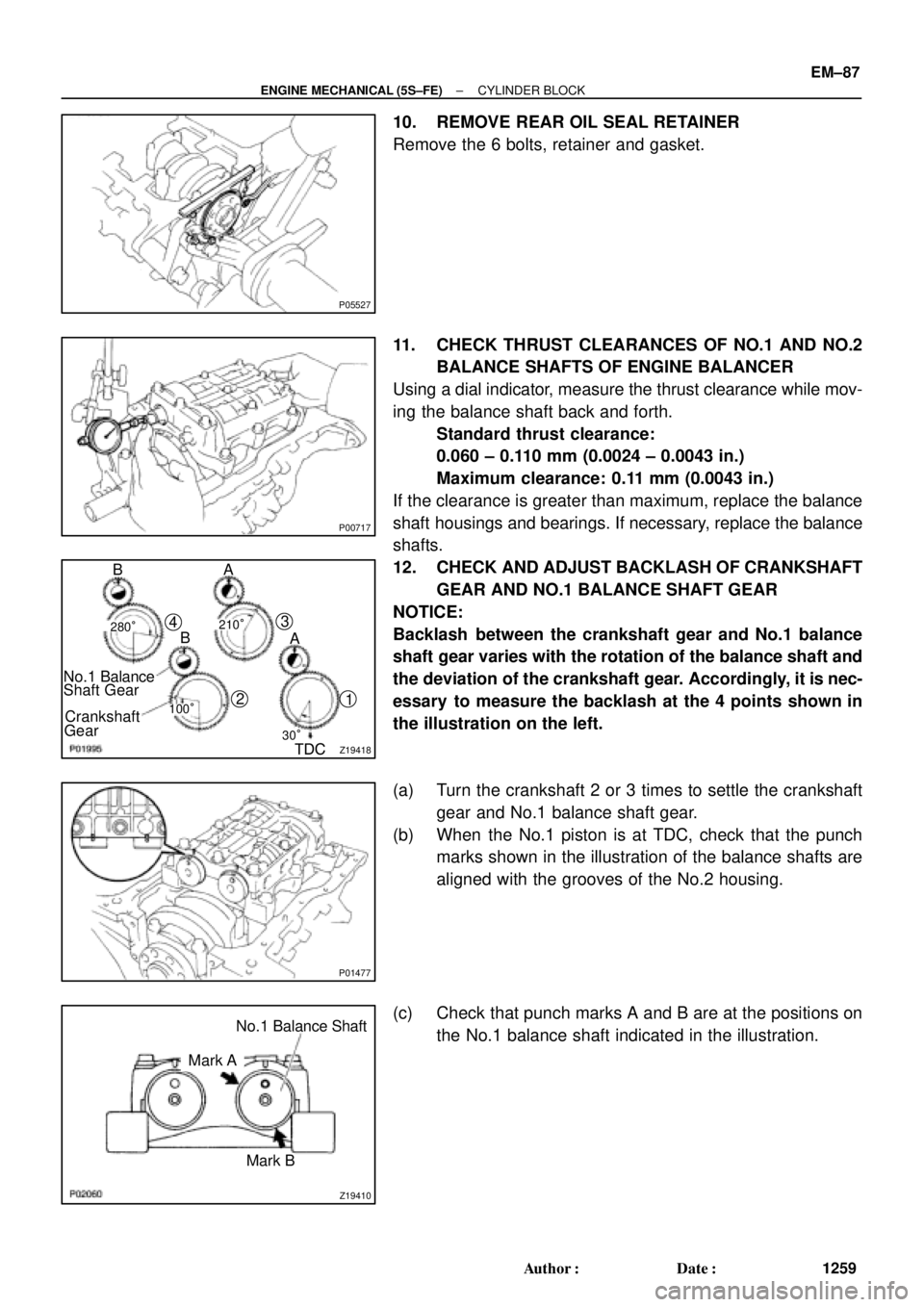
P05527
P00717
Z19418
No.1 Balance
CrankshaftA
A B B
1 23
4
30°TDC
Shaft Gear
Gear
210°
280°
100°
P01477
Z19410
No.1 Balance Shaft
Mark A
Mark B
± ENGINE MECHANICAL (5S±FE)CYLINDER BLOCK
EM±87
1259 Author�: Date�:
10. REMOVE REAR OIL SEAL RETAINER
Remove the 6 bolts, retainer and gasket.
11. CHECK THRUST CLEARANCES OF NO.1 AND NO.2
BALANCE SHAFTS OF ENGINE BALANCER
Using a dial indicator, measure the thrust clearance while mov-
ing the balance shaft back and forth.
Standard thrust clearance:
0.060 ± 0.110 mm (0.0024 ± 0.0043 in.)
Maximum clearance: 0.11 mm (0.0043 in.)
If the clearance is greater than maximum, replace the balance
shaft housings and bearings. If necessary, replace the balance
shafts.
12. CHECK AND ADJUST BACKLASH OF CRANKSHAFT
GEAR AND NO.1 BALANCE SHAFT GEAR
NOTICE:
Backlash between the crankshaft gear and No.1 balance
shaft gear varies with the rotation of the balance shaft and
the deviation of the crankshaft gear. Accordingly, it is nec-
essary to measure the backlash at the 4 points shown in
the illustration on the left.
(a) Turn the crankshaft 2 or 3 times to settle the crankshaft
gear and No.1 balance shaft gear.
(b) When the No.1 piston is at TDC, check that the punch
marks shown in the illustration of the balance shafts are
aligned with the grooves of the No.2 housing.
(c) Check that punch marks A and B are at the positions on
the No.1 balance shaft indicated in the illustration.
Page 3483 of 4770
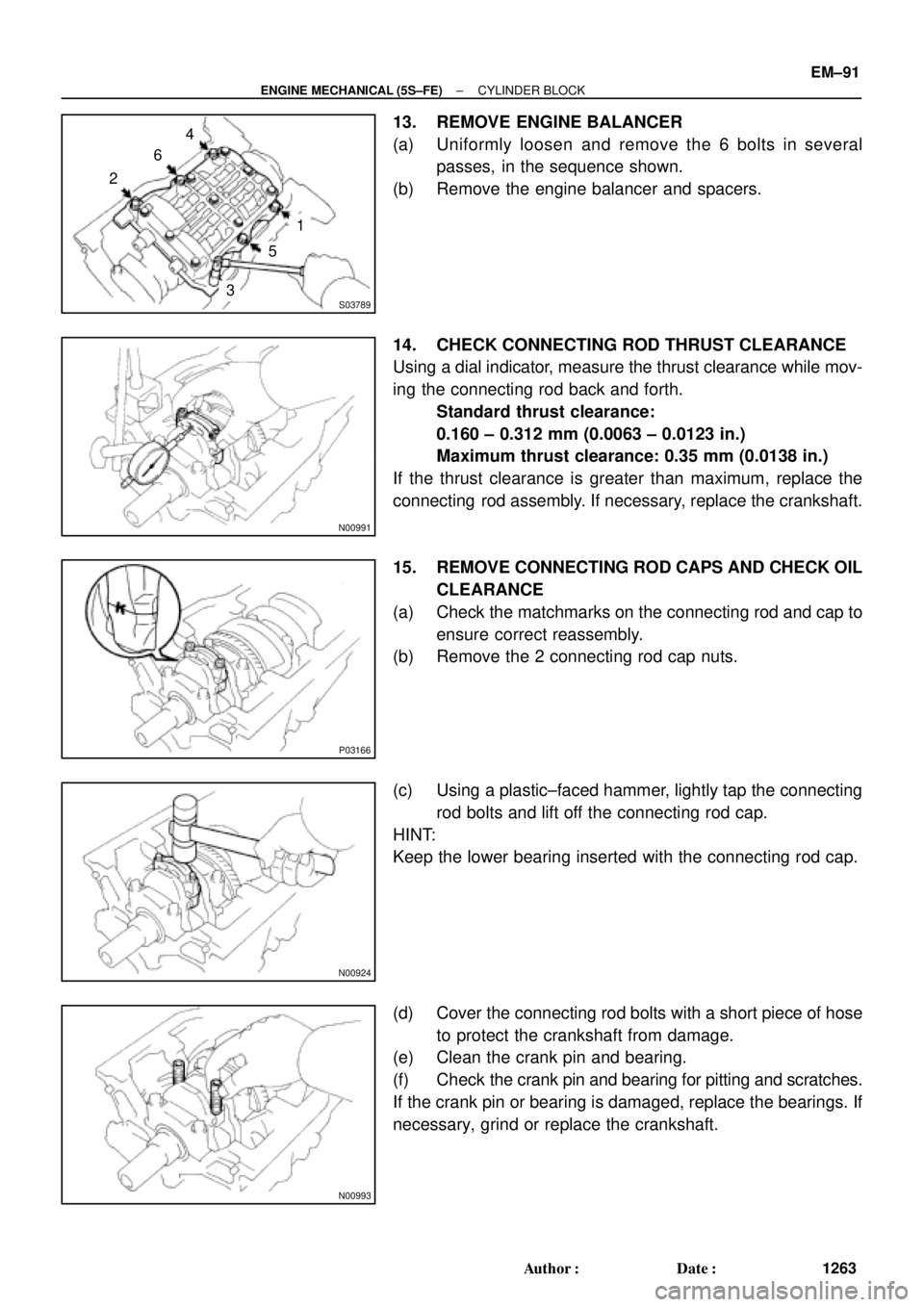
S03789
1
4
6
5
2
3
N00991
P03166
N00924
N00993
± ENGINE MECHANICAL (5S±FE)CYLINDER BLOCK
EM±91
1263 Author�: Date�:
13. REMOVE ENGINE BALANCER
(a) Uniformly loosen and remove the 6 bolts in several
passes, in the sequence shown.
(b) Remove the engine balancer and spacers.
14. CHECK CONNECTING ROD THRUST CLEARANCE
Using a dial indicator, measure the thrust clearance while mov-
ing the connecting rod back and forth.
Standard thrust clearance:
0.160 ± 0.312 mm (0.0063 ± 0.0123 in.)
Maximum thrust clearance: 0.35 mm (0.0138 in.)
If the thrust clearance is greater than maximum, replace the
connecting rod assembly. If necessary, replace the crankshaft.
15. REMOVE CONNECTING ROD CAPS AND CHECK OIL
CLEARANCE
(a) Check the matchmarks on the connecting rod and cap to
ensure correct reassembly.
(b) Remove the 2 connecting rod cap nuts.
(c) Using a plastic±faced hammer, lightly tap the connecting
rod bolts and lift off the connecting rod cap.
HINT:
Keep the lower bearing inserted with the connecting rod cap.
(d) Cover the connecting rod bolts with a short piece of hose
to protect the crankshaft from damage.
(e) Clean the crank pin and bearing.
(f) Check the crank pin and bearing for pitting and scratches.
If the crank pin or bearing is damaged, replace the bearings. If
necessary, grind or replace the crankshaft.
Page 3485 of 4770
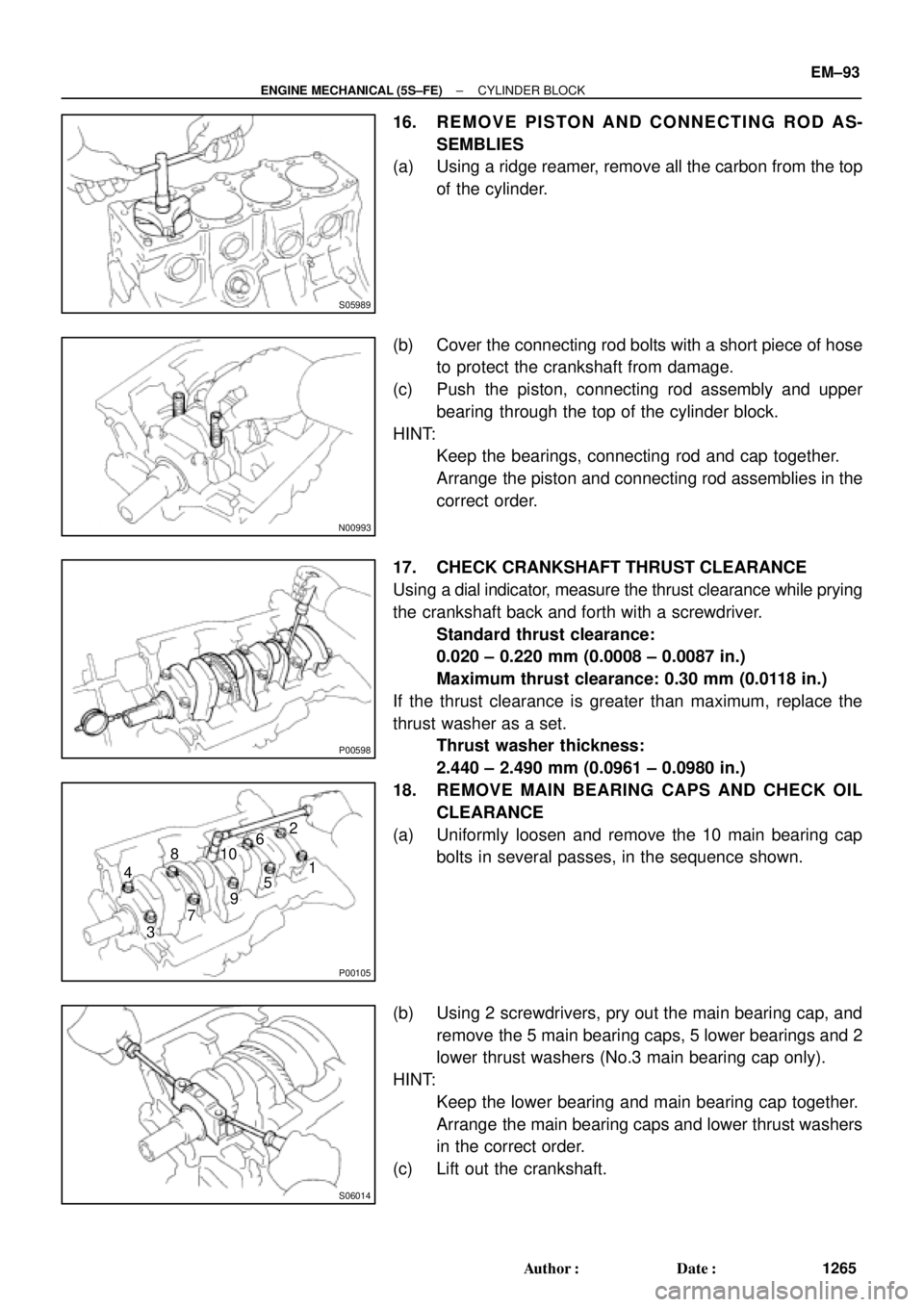
S05989
N00993
P00598
P00105
481062
1
5
9
7
3
S06014
± ENGINE MECHANICAL (5S±FE)CYLINDER BLOCK
EM±93
1265 Author�: Date�:
16. REMOVE PISTON AND CONNECTING ROD AS-
SEMBLIES
(a) Using a ridge reamer, remove all the carbon from the top
of the cylinder.
(b) Cover the connecting rod bolts with a short piece of hose
to protect the crankshaft from damage.
(c) Push the piston, connecting rod assembly and upper
bearing through the top of the cylinder block.
HINT:
�Keep the bearings, connecting rod and cap together.
�Arrange the piston and connecting rod assemblies in the
correct order.
17. CHECK CRANKSHAFT THRUST CLEARANCE
Using a dial indicator, measure the thrust clearance while prying
the crankshaft back and forth with a screwdriver.
Standard thrust clearance:
0.020 ± 0.220 mm (0.0008 ± 0.0087 in.)
Maximum thrust clearance: 0.30 mm (0.0118 in.)
If the thrust clearance is greater than maximum, replace the
thrust washer as a set.
Thrust washer thickness:
2.440 ± 2.490 mm (0.0961 ± 0.0980 in.)
18. REMOVE MAIN BEARING CAPS AND CHECK OIL
CLEARANCE
(a) Uniformly loosen and remove the 10 main bearing cap
bolts in several passes, in the sequence shown.
(b) Using 2 screwdrivers, pry out the main bearing cap, and
remove the 5 main bearing caps, 5 lower bearings and 2
lower thrust washers (No.3 main bearing cap only).
HINT:
�Keep the lower bearing and main bearing cap together.
�Arrange the main bearing caps and lower thrust washers
in the correct order.
(c) Lift out the crankshaft.
Page 3486 of 4770
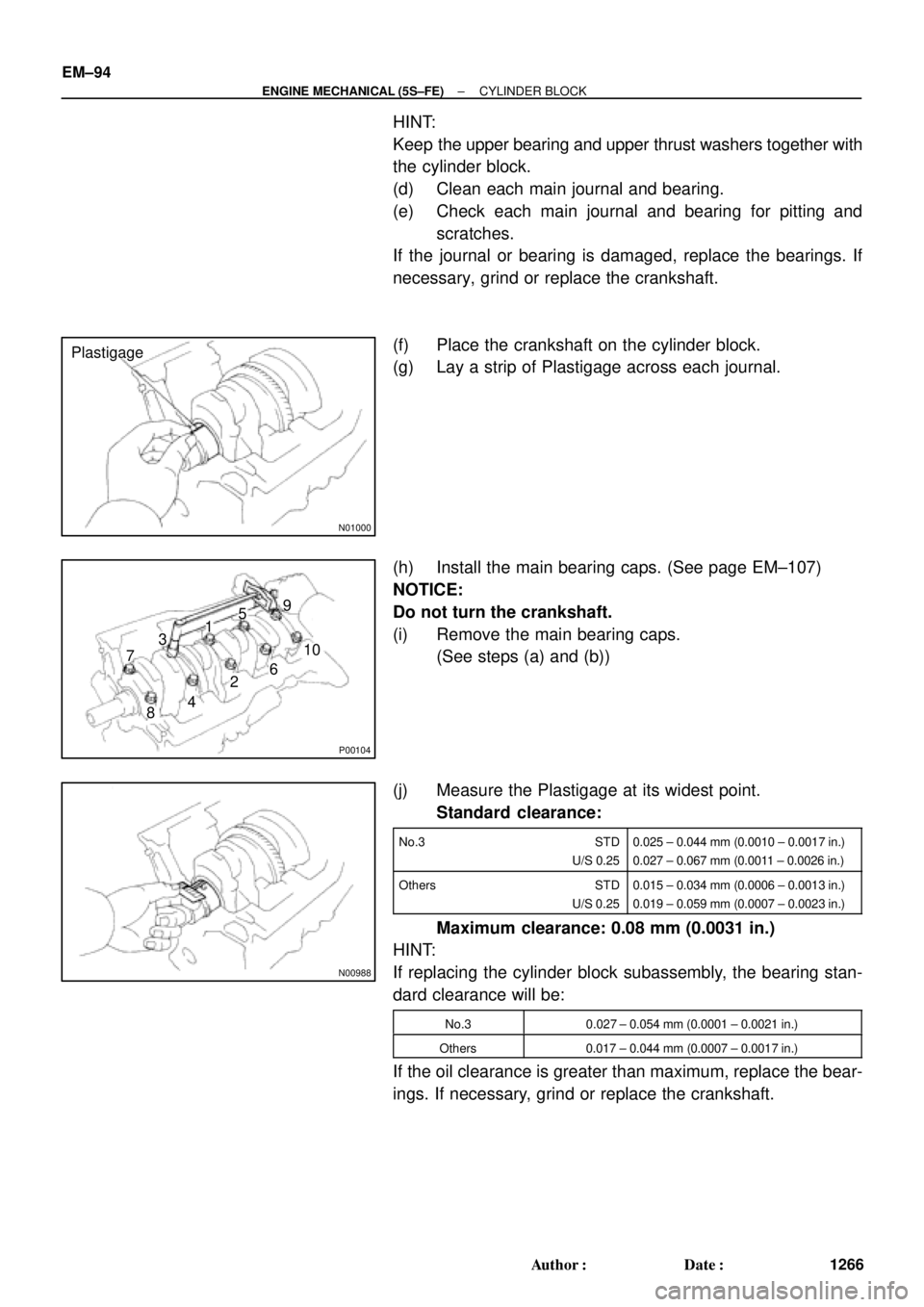
N01000
Plastigage
P00104
10 159
73
4
86
2
N00988
EM±94
± ENGINE MECHANICAL (5S±FE)CYLINDER BLOCK
1266 Author�: Date�:
HINT:
Keep the upper bearing and upper thrust washers together with
the cylinder block.
(d) Clean each main journal and bearing.
(e) Check each main journal and bearing for pitting and
scratches.
If the journal or bearing is damaged, replace the bearings. If
necessary, grind or replace the crankshaft.
(f) Place the crankshaft on the cylinder block.
(g) Lay a strip of Plastigage across each journal.
(h) Install the main bearing caps. (See page EM±107)
NOTICE:
Do not turn the crankshaft.
(i) Remove the main bearing caps.
(See steps (a) and (b))
(j) Measure the Plastigage at its widest point.
Standard clearance:
No.3 STD
U/S 0.250.025 ± 0.044 mm (0.0010 ± 0.0017 in.)
0.027 ± 0.067 mm (0.0011 ± 0.0026 in.)
Others STD
U/S 0.250.015 ± 0.034 mm (0.0006 ± 0.0013 in.)
0.019 ± 0.059 mm (0.0007 ± 0.0023 in.)
Maximum clearance: 0.08 mm (0.0031 in.)
HINT:
If replacing the cylinder block subassembly, the bearing stan-
dard clearance will be:
No.30.027 ± 0.054 mm (0.0001 ± 0.0021 in.)
Others0.017 ± 0.044 mm (0.0007 ± 0.0017 in.)
If the oil clearance is greater than maximum, replace the bear-
ings. If necessary, grind or replace the crankshaft.
Page 3488 of 4770
A06590
A06589
A06587
A01774
A01775
EM±96
± ENGINE MECHANICAL (5S±FE)CYLINDER BLOCK
1268 Author�: Date�:
20. CHECK FIT BETWEEN PISTON AND PISTON PIN
Try to move the piston back and forth on the piston pin.
If any movement is felt, replace the piston and pin as a set.
21. REMOVE PISTON RINGS
(a) Using a piston ring expander, remove the No.1 and No.2
piston rings.
(b) Remove the 2 side rails and oil ring expander by hand.
HINT:
Arrange the piston rings in correct order only.
22. DISCONNECT CONNECTING ROD FROM PISTON
(a) Using a small screwdriver, pry out the 2 snap rings.
(b) Gradually heat the piston to 80 ± 90°C (176 ± 194°F).
(c) Using a plastic±faced hammer and brass bar, lightly tap
out the piston pin and remove the connecting rod.
HINT:
�The piston and pin are a matched set.
�Arrange the pistons, pins, rings, connecting rods and
bearings in the correct order.
Page 3489 of 4770
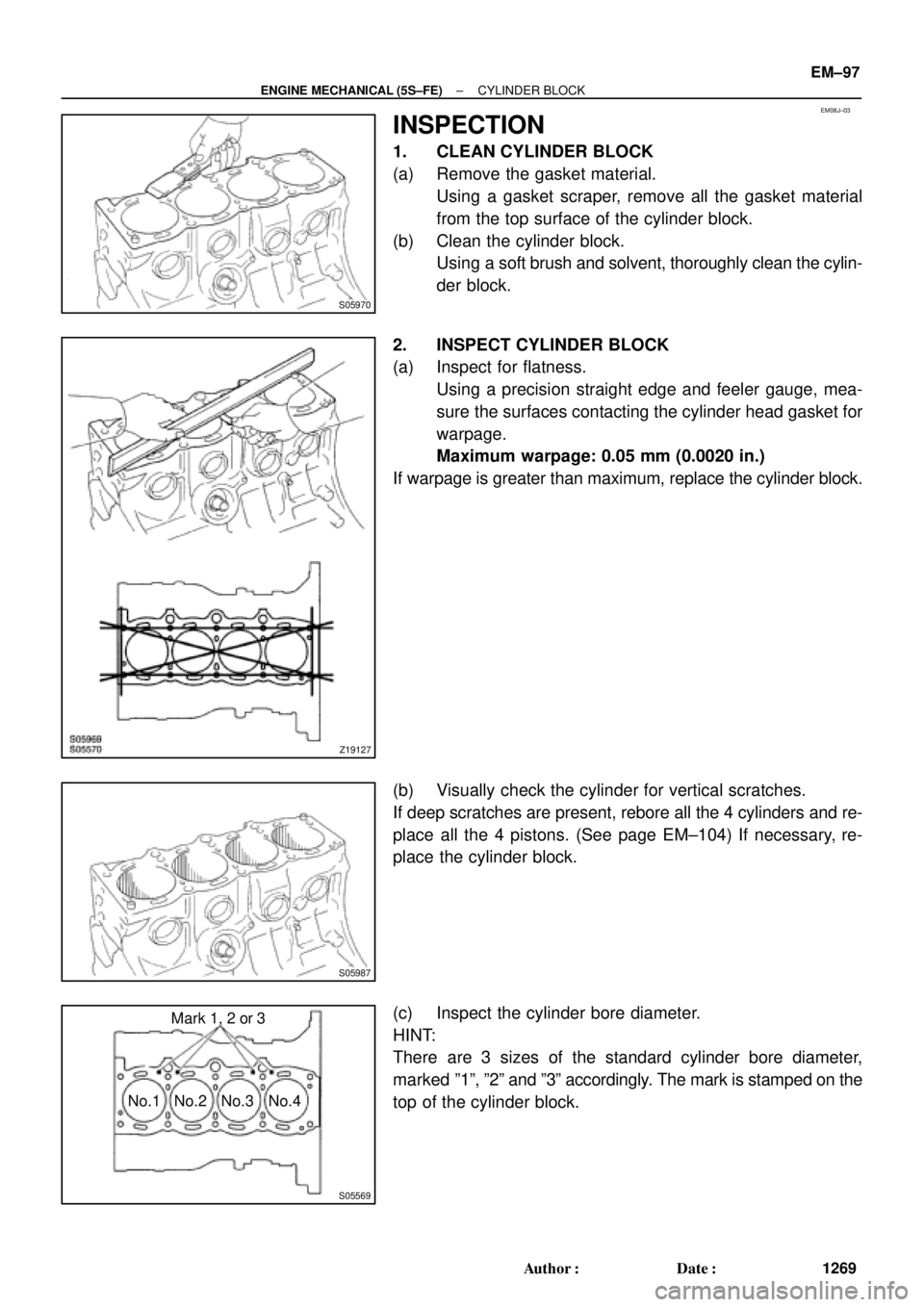
EM08J±03
S05970
Z19127
S05987
S05569
No.1 No.2 No.3 No.4Mark 1, 2 or 3
± ENGINE MECHANICAL (5S±FE)CYLINDER BLOCK
EM±97
1269 Author�: Date�:
INSPECTION
1. CLEAN CYLINDER BLOCK
(a) Remove the gasket material.
Using a gasket scraper, remove all the gasket material
from the top surface of the cylinder block.
(b) Clean the cylinder block.
Using a soft brush and solvent, thoroughly clean the cylin-
der block.
2. INSPECT CYLINDER BLOCK
(a) Inspect for flatness.
Using a precision straight edge and feeler gauge, mea-
sure the surfaces contacting the cylinder head gasket for
warpage.
Maximum warpage: 0.05 mm (0.0020 in.)
If warpage is greater than maximum, replace the cylinder block.
(b) Visually check the cylinder for vertical scratches.
If deep scratches are present, rebore all the 4 cylinders and re-
place all the 4 pistons. (See page EM±104) If necessary, re-
place the cylinder block.
(c) Inspect the cylinder bore diameter.
HINT:
There are 3 sizes of the standard cylinder bore diameter,
marked º1º, º2º and º3º accordingly. The mark is stamped on the
top of the cylinder block.
Page 3493 of 4770
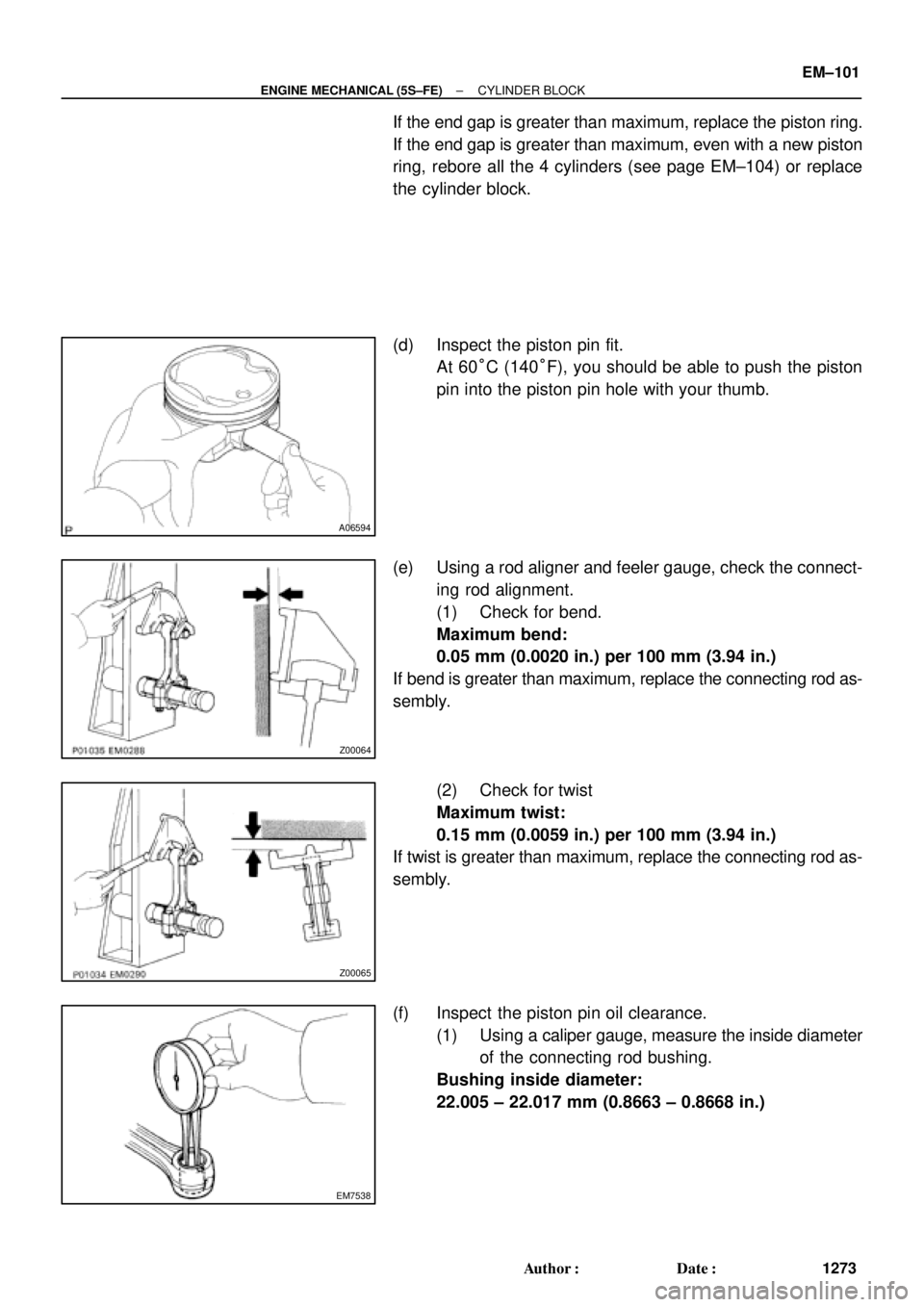
A06594
Z00064
Z00065
EM7538
± ENGINE MECHANICAL (5S±FE)CYLINDER BLOCK
EM±101
1273 Author�: Date�:
If the end gap is greater than maximum, replace the piston ring.
If the end gap is greater than maximum, even with a new piston
ring, rebore all the 4 cylinders (see page EM±104) or replace
the cylinder block.
(d) Inspect the piston pin fit.
At 60°C (140°F), you should be able to push the piston
pin into the piston pin hole with your thumb.
(e) Using a rod aligner and feeler gauge, check the connect-
ing rod alignment.
(1) Check for bend.
Maximum bend:
0.05 mm (0.0020 in.) per 100 mm (3.94 in.)
If bend is greater than maximum, replace the connecting rod as-
sembly.
(2) Check for twist
Maximum twist:
0.15 mm (0.0059 in.) per 100 mm (3.94 in.)
If twist is greater than maximum, replace the connecting rod as-
sembly.
(f) Inspect the piston pin oil clearance.
(1) Using a caliper gauge, measure the inside diameter
of the connecting rod bushing.
Bushing inside diameter:
22.005 ± 22.017 mm (0.8663 ± 0.8668 in.)